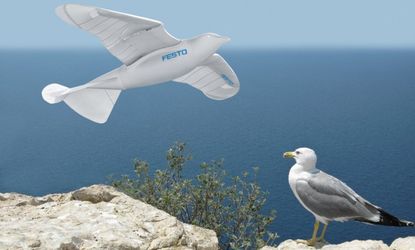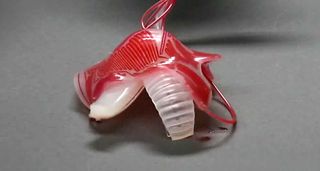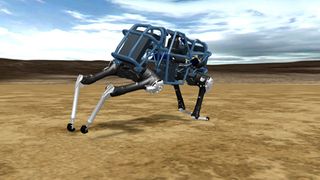These drones scuttle, swarm, slither, and squirm
The Pentagon is looking increasingly like The Island of Doctor Moreau

Once inspired by slow-moving prop planes, military researchers are increasingly turning to the deadly bio-mechanics of the animal kingdom for their blueprints. Think drones that scuttle, swarm, slither, and squirm.
But as scary as that sounds, fear isn't the primary motivator behind these drones. This isn't PSYOPS. Instead, by mimicking nature, drones have become smaller, lighter, and more nondescript than ever. In other words, they're becoming even more stealthy. They'll soon be able to operate autonomously, conduct surveillance missions for days on end, and even re-charge their own batteries while on the prowl.
So how do these drones actually look and act? Here, the new zoology of drones:
Subscribe to The Week
Escape your echo chamber. Get the facts behind the news, plus analysis from multiple perspectives.

Sign up for The Week's Free Newsletters
From our morning news briefing to a weekly Good News Newsletter, get the best of The Week delivered directly to your inbox.
From our morning news briefing to a weekly Good News Newsletter, get the best of The Week delivered directly to your inbox.
BIRDS

Pigeons
Earlier this year, the Air Force revealed that its research arm, the Air Vehicles Directorate, is seeking to build Micro Air Vehicles (MAVs) that resemble small birds. In an animated video, the Air Force showed an autonomous pigeon-shaped drone that perches on a wire as it surveys a target while simultaneously gathering energy from the power line.
Hummingbirds
Sign up for Today's Best Articles in your inbox
A free daily email with the biggest news stories of the day – and the best features from TheWeek.com
The pigeon isn't the first example of a bird-like drone. In 2011, Pentagon researchers crafted a 19-gram hummingbird that can flit about like the real thing. With a camera in its belly, the highly agile drone flies at speeds of up to 11 miles per hour, propelled solely by its two rapidly fluttering wings.
Seagulls
Never to be outdone in feats of engineering, German engineers have also produced a drone that mimics a bird: A 0.8-pound Smartbird, which flaps its wings and soars like a seagull. The drone can even take off and land on its own.
INSECTS

Flies
The Air Force has also showcased its concept of fly-like drones that can covertly operate in confined urban areas such as apartment complexes. Hordes of these MAVs can work together to survey a wide area for real-time situational awareness, and drones within the swarm can even be given specialized tasks like incapacitating targets through chemical injections or explosives.
Butterflies
Last year, an Israeli defense firm unveiled a 20-gram butterfly-inspired drone designed to spy on targets inside buildings with a 0.15-gram camera and memory card. Outfitted with translucent wings, the tiny drone resembles a large moth and flies practically without a sound as it beats its wings 14 times per second. The drone is so realistic that during tests birds and flies would fall behind the device in a flock formation.
Dragonflies
Festo, a German engineering firm, has built a 17.3-inch dragonfly that can hover and move in any direction with its four wings that each flap and rotate independently. The smart phone controlled drone even has a maneuverable head and tail.
Roaches
For $65, anyone can purchase DASH, a 10-cm, six-legged smart phone controlled roach-drone that can survive a 92-foot drop and scurry like a cockroach, sprinting towards a ledge, grabbing a hold of the edge, and then hanging beneath it to avoid detection. No word yet on how it fares after being smashed by a shoe, though.
SEA CREATURES

Octopus
Harvard researchers are at work on a drone that squirms like an octopus. The soft-bodied drone can wriggle its way through obstacles that rigid metal-bodied drones can't. In addition, by streaming liquid dyes through its rubber body, the drone can change color, camouflaging itself to blend in with its environment or stand out like a signal.
Tuna
The Department of Homeland Security has deployed an unmanned underwater vehicle (UUV) that darts through the water like a powerful tuna. Highly maneuverable and equipped with an array of sensors, the drone is ideal for inaccessible areas like flooded parts of ships, and can even swim through highly viscous fluids like crude oil.
LAND ANIMALS

Cheetahs
Last year, Boston Dynamics set a land speed record with its Cheetah-inspired robot. At 28.3 miles per hour, the sprinting drone can out run Usain Bolt, the world's fastest human. Still in development, researchers say it will eventually reach speeds of up to 70 miles per hour.
Dogs
On the slower end of the spectrum, Boston Dynamics' AlphaDog clambers over rough terrain like a mule, carrying up to 400 pounds as far as 20 miles without refueling. Even if that doesn't sound as awe-inspiring as a swarm of assassin flies, AlphaDog would be incredibly useful for troops who'd otherwise have to lug that heavy gears themselves.
Snakes
For those hard to reach places, British engineers at OC Robotics have developed a robotic arm that slithers like a snake, capable of bending, curving, and extending like its genetic inspiration.
BONUS: FLORA
Maple seeds
Looking beyond the animal kingdom, Lockheed Martin has developed the Samurai, an MAV that floats and twirls like a maple seed. The 30-cm drone is highly maneuverable, can fly within buildings, fits in your pocket, and is launched with a flick of the wrist. More disconcertingly, hordes of these MAVs could soon be operating autonomously as Boeing engineers have already successfully demonstrated how current aerial drones can operate like a swarm of insects, communicating and carrying out tasks in mid-air.
Create an account with the same email registered to your subscription to unlock access.
Eugene K. Chow is a speechwriter and freelance journalist. He is the former executive editor of Homeland Security NewsWire. Previously, he was a research assistant at the Center for A New American Security, a Washington-D.C. based think tank.
-
 'Republicans want to silence Israel's opponents'
'Republicans want to silence Israel's opponents'Instant Opinion Opinion, comment and editorials of the day
By Harold Maass, The Week US Published
-
 Poland, Germany nab alleged anti-Ukraine spies
Poland, Germany nab alleged anti-Ukraine spiesSpeed Read A man was arrested over a supposed Russian plot to kill Ukrainian President Zelenskyy
By Peter Weber, The Week US Published
-
 Today's political cartoons - April 19, 2024
Today's political cartoons - April 19, 2024Cartoons Friday's cartoons - priority delivery, USPS on fire, and more
By The Week US Published